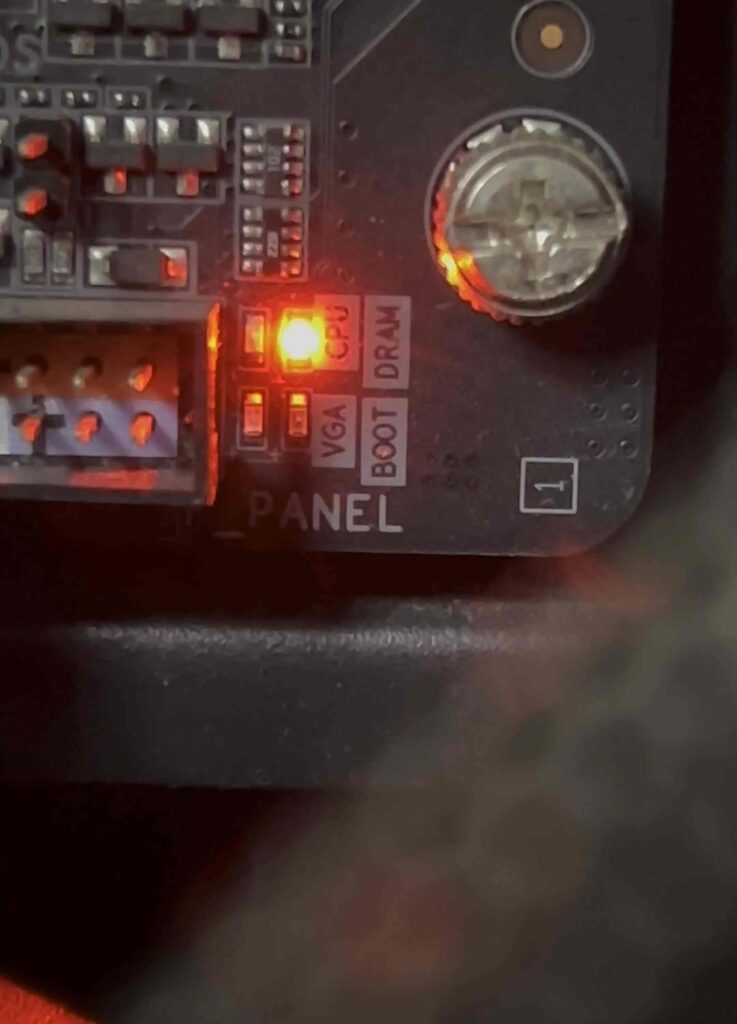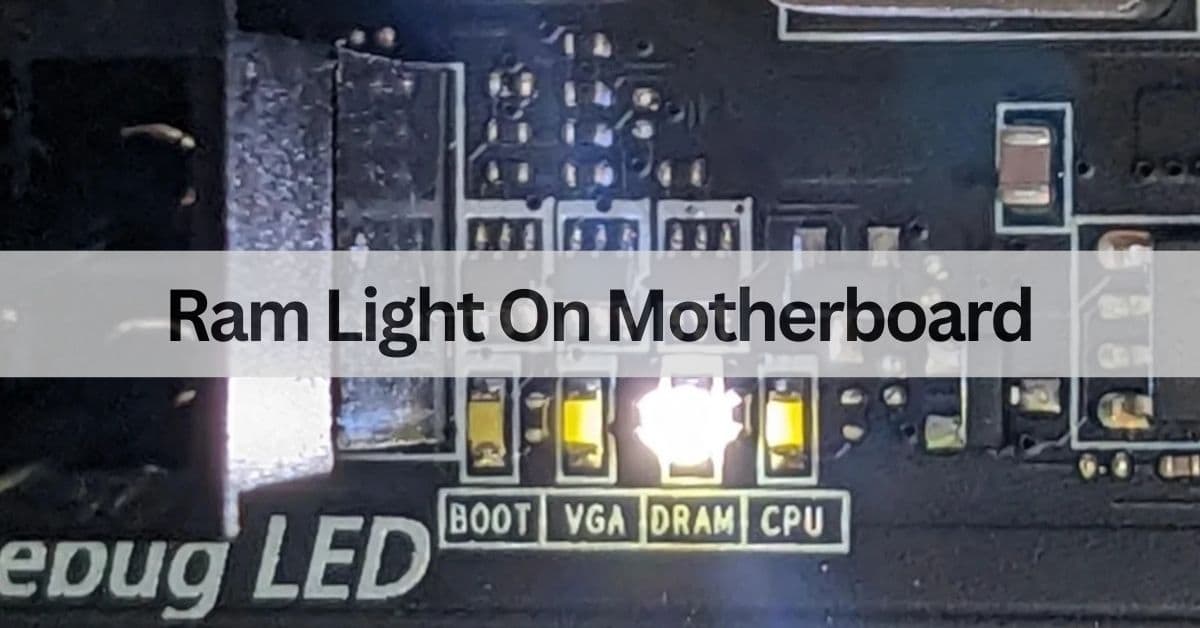I once faced a frustrating issue with the RAM light on my motherboard. After some troubleshooting, I found simple fixes that resolved the problem quickly. Here’s what I learned from that experience and how you can avoid similar issues.
The RAM light on the motherboard usually indicates an issue with the RAM. It could be a loose connection, faulty RAM, or compatibility problem. Checking connections and replacing defective parts can help fix this issue.
In this article, we will discuss all about “Ram Light On Motherboard”.
Table of Contents
What is the RAM Light on Motherboard?

The RAM light on a motherboard usually indicates an issue with the RAM or its connection. When this light turns on, the motherboard is not detecting the RAM correctly, which can be caused by loose connections, faulty RAM, or incompatible parts.
Read More: What Is Orange Motherboard Light – Quick Troubleshooting Guide!
Common Causes of RAM Light Activation:
1. Improper RAM Installation:
Improper RAM installation can cause issues, such as the RAM light turning on. Make sure the RAM is securely placed in its slot. Check for dust or debris, and reseat it carefully if needed.
2. Faulty RAM Modules:
Faulty RAM modules can cause your computer to freeze, crash, or not boot properly. If you suspect your RAM is the issue, try reseating it or replacing it with a working one to see if it solves the problem.
3. Incompatible RAM:
Incompatible RAM happens when your RAM doesn’t match the motherboard or isn’t supported. This can cause errors, crashes, or the system not booting. Always check compatibility before installing new RAM for a smooth experience.
4. Incorrect RAM Slot:
If the RAM light is on, it could be due to incorrect RAM slot placement. Try moving the RAM sticks to different slots, ensuring they are correctly seated. This can often solve the issue quickly.
5. Motherboard Issues:
Motherboard issues can cause problems, such as the computer not starting or random shutdowns. Common causes include damaged components, loose connections, or outdated drivers. Fixing these issues usually requires checking connections or updating software.
6. Power Supply Problems:
Power supply problems can cause your motherboard to malfunction or not start at all. It might be due to an insufficient power supply or a faulty connection. Always check the power cables and connections first.
How to Troubleshoot the RAM Light on Motherboard:
If the RAM light on your motherboard is on, first check if the RAM sticks are installed properly. Remove and reinsert them if needed. Next, test each stick in different slots to find any faulty ones. If the issue persists, try resetting or updating the BIOS. If nothing works, consider replacing the RAM.
How to Reset the BIOS:
1. Using the BIOS Reset Jumper:
The BIOS reset jumper can fix motherboard issues by resetting the default settings. This simple method helps resolve problems caused by incorrect BIOS settings, ensuring your motherboard works as expected.
2. Removing the CMOS Battery:
Removing the CMOS battery can reset your motherboard settings to default. This may fix issues like the RAM light staying on. Simply remove the battery for a few minutes, then put it back in.
3. Using BIOS Setup Utility:
The BIOS Setup Utility allows you to adjust settings for your motherboard, such as boot order and hardware configurations. It’s a valuable tool for troubleshooting and optimizing your computer’s performance without needing extra software.
4. Clearing the CMOS Using a Key Combination:
Clearing the CMOS using a key combination resets your motherboard’s settings. To do this, turn off the PC, press a specific key combination (usually involving the power button), and wait for the reset to complete.
What does the RAM light on the motherboard indicate?

The RAM light on the motherboard usually indicates a RAM issue. Loose RAM sticks, incorrect installation, or faulty modules could cause it. You can fix this by checking connections, reinstalling the RAM, or replacing it.
Read More: Can I Use 1866mhz Ram On 1600 Motherboard – What You Need To Know!
How can I fix the RAM light on my motherboard?
To fix the RAM light on your motherboard, first, check if the RAM is seated correctly in its slot. Try reseating it or switching slots. If the issue continues, test each RAM stick individually and ensure your motherboard and RAM are compatible.
Why is my RAM light flashing on the motherboard?
A flashing RAM light on the motherboard usually means an issue with your RAM. It could be a loose connection, faulty RAM sticks, or incompatible parts. Try reseating the RAM or testing each stick to identify and fix the problem.
How do I know if the RAM is properly installed when the light is on?
If the RAM light is on, it could mean the RAM is not installed correctly. Check if the RAM is securely placed in the slot and properly aligned. You may need to remove and reinstall it to ensure it clicks into place firmly.
Does the color of the RAM light on the motherboard matter?
- Red Light: A red RAM light often indicates an issue with the RAM, such as improper installation or a failure to detect the RAM. It may also suggest a compatibility issue between the motherboard and RAM.
- White Light: A white light can sometimes indicate that the motherboard is receiving power but is not detecting the RAM properly. It can also indicate a hardware malfunction.
- Blue or Green Light: These lights typically mean the system operates normally, with the RAM recognized and functioning correctly. These colors usually indicate no issues.
- Flashing Lights: If the RAM light is flashing, it may point to an intermittent issue with the RAM, such as a loose connection, a faulty module, or an unstable power supply.
Should the DRAM light be on?
If the DRAM light is on, it usually means the RAM has an issue. This could be a loose connection, faulty RAM, or a motherboard problem. Check the RAM sticks, ensure they are correctly seated, and test them in different slots if needed.
Why is my RAM light red?
A red RAM light on your motherboard usually means there’s an issue with your RAM. Loose connections, incompatible RAM, or a fault in the motherboard could cause it. Check if the RAM is correctly installed or try reseating it to fix the problem.
What does a yellow DRAM light mean?
A yellow DRAM light on your motherboard usually indicates a RAM issue. It could be caused by incorrect installation, faulty RAM, or compatibility problems. Check if the RAM is seated correctly, or try a different RAM stick to fix the problem.
What to Do If DRAM Light on Motherboard Is Turned On?
If the DRAM light on your motherboard is turned on, it usually means there is an issue with the RAM. Try reseating the RAM sticks, cleaning the slots, or testing with different RAM to see if the issue is resolved. If not, check for motherboard damage.
How to fix ram light on motherboard?
First, check if the RAM is installed correctly to fix the RAM light on your motherboard. Remove and reseat it if necessary. Ensure the RAM is compatible with the motherboard. Also, try updating the BIOS or resetting the motherboard to solve any software issues.
DRAM light on motherboard no display:

If the DRAM light on your motherboard is on and there’s no display, it usually means there is an issue with your RAM. Try reseating the RAM sticks or testing them in different slots. If the problem persists, you may need to replace the RAM.
Read More: What Are Power Stages On A Motherboard – What You Need To Know!
FAQs:
1. What should I do if the DRAM light stays on?
If the DRAM light stays on, check if your RAM is properly seated. Try reseating the sticks or moving them to different slots.
2. How can I fix a motherboard with no display?
To fix no display, check the connections, ensure your RAM and GPU are correctly installed, and test with another monitor or cable.
3. Why does the DRAM light appear on my motherboard?
The DRAM light typically indicates an issue with your RAM, such as improper installation or faulty RAM sticks.
4. Can a faulty RAM cause a no display issue?
Yes, faulty or improperly installed RAM can prevent the motherboard from displaying anything on the screen.
5. How can I test my RAM for issues?
You can test your RAM using one stick at a time or a memory diagnostic tool to check for errors.
6. What happens if my motherboard’s DRAM light is on after installing new RAM?
If the DRAM light stays on after installing new RAM, it may not be compatible or properly seated. Try reseating it or checking for compatibility issues.
Conclusion:
The DRAM light on your motherboard usually indicates a RAM issue. Reseating or testing the RAM in different slots can help resolve the problem. If it continues, replacing the RAM might be necessary. Proper installation and compatibility are vital to avoiding these issues.
